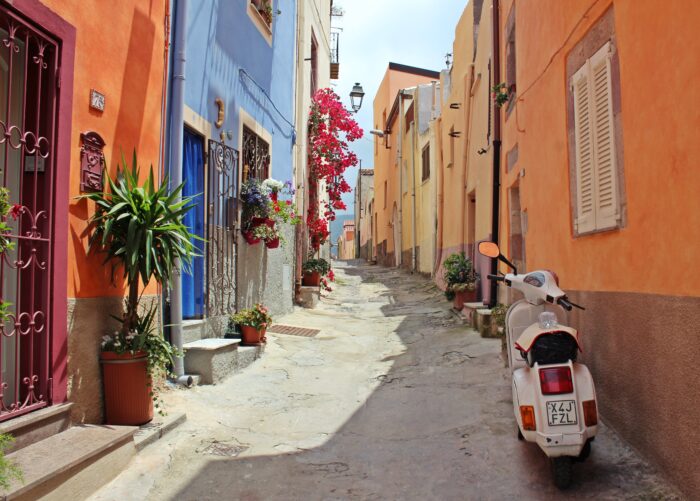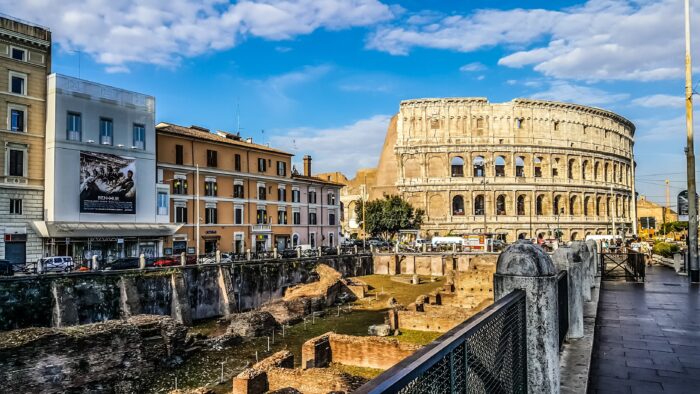Americans living in Italy
Buongiorno! Have you always dreamed of living in Italy? Where every corner reveals a masterpiece, and every meal is a symphony of flavors. Whether it’s the allure of historic art and architecture or the irresistible aroma of freshly baked pizza and the sweet taste of gelato, Italy has been calling Americans for decades.

If the idea of waking up to the beauty of UNESCO World Heritage Sites every day sounds like the life you’ve always craved, then let’s explore the possibilities of relocating to Italy together!
Can Americans move to Italy?
We get this question a lot and the answer is, yes….but.
US citizens can visit Italy for a total of 90 days within a 180-day period as a tourist. But to move to Italy from the US you’ll need to get your paperwork in order, which means you’ll need to obtain a visa, and there are a few that you can choose from. We’ll talk about more them in the next section.
You can also move to Italy if you obtain Italian citizenship. Many Americans meet the requirements to obtain Italian citizenship by descent. If you’re eligible, you could gain an Italian passport and all rights to live and work anywhere in the European Union without the need for a visa or 90-day limitations. Check with your local Italian embassy for more information.
How to move to Italy
As with any major life decision, relocating to Italy requires time, patience, and research. First, ask yourself, what’s your reason for moving to Italy from the US? Is it the opportunity to reconnect with your ancestors? Or maybe it’s the allure of la dolce vita?
Once you know your “why,” check out our list of the 12 things to do before you move abroad. If you need even more guidance be sure to join our Move Abroad After 30 Masterclass.
In addition to doing your due diligence, try to spend as much time as possible in your future Italian town or city so that you have a better sense of what to expect once you officially move abroad. This can help mitigate potential challenges like expat depression and the stress that comes with finding an apartment abroad.
Visas for Italy
Italy has a few visa options for Americans who’d like to live in the country for an extended period of time. If you’re ready to make your move here are your best options for long stay visas for Italy:
Student visa: A student visa allows you to live in Italy for the duration of your studies, either by enrolling at a university or certain approved language academies.
Work visa: A work visa is extremely difficult for Americans to obtain but if you’re lucky enough to score a job offer from an Italian company, this might just be your ticket in to living in Italy!
Elective residence visa: This visa allows you to live in Italy as long as you aren’t seeking work and have proof of financial means to support yourself.
Self-employment visa: This option is for freelancers and self-employed individuals who want to work in Italy or set up their own business.
For more information on all your viable visa options, their requirements and how to apply, get your copy of I’m Outta Here! An American’s Ultimate Visa Guide to Living in Europe. In this digital book you’ll find more information on the aforementioned visas as well as 50+ other visa options for the 18 easiest countries to move to in Europe!
Digital nomad visa Italy
In March 2022, Italy approved a digital nomad visa for remote workers, however, since then there has been a lot of speculation but the visa has been launched yet.
Information for Italy’s digital nomad visa is limited and specific details have not been released, but we’ll update this space when there’s more info. Be sure to join the She Hit Refresh mailing list to be the first to know!
Jobs in Italy for English speakers and jobs in Italy for Americans
US citizens do not have the right to work in Italy. In order to work in Italy as an American you will need obtain a work visa, which will allow you to legally work in the country. This is not easy as you will need to find an Italian company willing to sponsor your Italian work permit.
Some of the most popular jobs in Italy for English speakers are in the tourism sector and teaching English. Other high-demand jobs that Americans may qualify for include working for an international company focused on tech, science, finance, engineering or other qualified skilled laborer. In addition to having the right credentials, speaking Italian can help you stand out from the competition.
If obtaining a work visa seems out of reach, another option may be to work remotely for a company located outside of Italy if you’re able to obtain a self-employment visa.
Cost of living in Italy
The cost of living in Italy will depend on the region, city, location, and your own living standards. However, in general life in Italy will be about 30% cheaper than what it costs to live in a major city in the United States.
For example, a monthly transit ticket in Rome will run about $50 while in New York City you can expect to pay $127. Rent will also run about 44% cheaper in Rome versus New York City. Produce is also much less expensive and better quality throughout the country.

Prices for daily expenses and rent are even cheaper if you decide to live in a smaller town or village. Furthermore, while the northern part of Italy tends to be more expensive than the south, prices are still affordable throughout the country. For instance, it’ll cost just over a dollar for one-way transit ticket and a gallon of milk in the southern region of Puglia. A one bedroom apartment, outside the center, will set you back just $500 a month!
Overall expenses in Italy aren’t as nearly as high as other Western European countries such as Ireland and France. However, like most of Europe, gas and electric can add up and be a surprise if you’re used to American prices.
Since many people interested in relocating to Italy consider living in Rome and Florence, read on to learn about what your expenses might be if you choose to live in these cities.
Cost of living in Rome
Living in Rome as an American is quite affordable. A one bedroom apartment in the heart of the city will set you back about $1200 (compare that to $4100 in New York City!). You can anticipate paying approximately $35 for internet and nearly $200 per month on utilities if you decide to make Rome your home.
Cost of living in Florence
While overall expenses for a single person in Florence are slightly less than Rome, you can still expect to pay about €750 for a centrally located apartment. Your monthly utility costs will also be slightly less than Rome.
Best places to live in Italy
You’ve just read about the cost of living in Rome and Florence. In the following section, you’ll learn more about why these cities, as well as a couple of others, are considered some of the best places for Americans moving in Italy.

Rome: Aside from being the largest city in the country, Rome is appealing to those seeking to live in a part of Europe that’s rich in history and culture. Foreigners are also drawn to Rome for its work/life balance, opportunities to build community, close access to the sea, and lower cost of living compared to many other Western European countries.
Milan: As the fashion capital and one of the most modern cities in Italy, Milan appeals to expats interested in a trendier lifestyle. Even though it’s the most expensive city in Italy, it’s still more affordable than living in European countries like the Netherlands and Germany.
Milan’s location also makes it convenient for traveling to northern Italy and other parts of Europe. Additionally, English is more widely spoken here.

Bologna: Known as the food capital of Italy, if you’re a foodie who loves lasagna and tortellini, you might want to consider getting an apartment or house in Bologna. With a population of about 390,000 people, this charming city is also home to the University of Bologna and students from all over the world. Compared to other Italian cities, Bologna is more liberal and vibrant. There are also plenty of opportunities to enjoy concerts, take in a museum, and attend cultural events.
Florence: Based in the Central-Northern part of Italy, Florence is the capital of the Tuscany region. Along with being more affordable than Milan and Rome, you’ll get to experience all four seasons if you decide to live here. Of course, another perk to living in this part of Italy is treating yourself to wine from Tuscany anytime you’d like!

For more information about the best cities for Americans relocating to Italy, check out I’m Outta Here! An American’s Ultimate Visa Guide to Living in Europe. You’ll find an overview of everything you need to know from the cost of living to the social scene, climate, safety and more!
Pros and cons of living in Italy
Living in Italy pros and cons is something you’ll need to consider if you’re thinking of relocating. Let’s start with the positive: some of the best news is that it’s affordable country to live in and has excellent health care system. Other pros to making Italy your new home is that you’ll be able to eat fresh and wholesome food every day, have access to a topnotch education system, good public transport, gorgeous scenery, and a rich culture and history.
Essentially you’ll be living where many Americans only dream of having their ideal vacation! Along with all these benefits, you’ll get to enjoy meeting friendly Italians too.
However, no place is perfect. You may also face some challenges. This includes adapting to extreme weather patterns in parts of the country, finding a job, learning Italian, and dealing with culture shock. There’s also high unemployment and it’s important to note that English is not widely-spoken.
Health insurance in Italy
Italy has an excellent health care system that’s extremely affordable compared to the United States. However, care can vary depending on the region of the country. Generally speaking, healthcare is considered better in the northern part of the country compared to the system in the south.
Most Americans are eligible to access to the public health care system once they’ve met their visa residency requirements. Before then you’ll need to purchase a private plan. To learn more about healthcare in Italy and popular private insurance companies, grab your copy of I’m Outta Here! An American’s Ultimate Visa Guide to Living in Europe.
Can U.S citizens retire in Italy?
Similar to Spain and Portugal, Italy does not have a specific residence permit for retirees. However, like both countries, there is a visa option for those who can provide proof of income and do not intend to work. Again, you can find more information about visas for retirees in I’m Outta Here! An American’s Ultimate Visa Guide to Living in Europe.

Purchasing property in Italy
The United States and Italy have an agreement that allows citizens from either country to buy a home in the other country. But keep in mind that purchasing property in Italy isn’t nearly as straightforward as it might be in the U.S. Therefore, it’s recommended to work with a licensed and reputable real estate agent. Feel free to reach out to members of She Hit Refresh’s community to learn from other expats who’ve bought property in Italy.
An American expat in Italy
Jennifer, 49, is both a survivor and thriver. Originally from St. Louis, Missouri, her refresh to Italy was far from an overnight process. During the 10-year span it took Jennifer to make her way to Italy, she left an abusive marriage, dealt with two significant health crises, and processed a failed second career.
Upon leaving her toxic relationship, Jennifer took time to regroup. This led to her accepting a teaching position in China that turned into a three year stint. She also dealt with a brain injury and severe COVID lockdowns during this time. These events propelled Jennifer to research how she could start a new life in Italy.
Jennifer made her move to Italy by qualifying for citizenship by descent because her great-grandparents were part of the massive migration that took place in the early 1900s from Italy to America. Since her great-grandparents had become U.S. residents, they were given the choice in the 1940s, (as WW2 came to a close), to obtain U.S. citizenship or be interned. They opted to become US citizens.
In the 1990s Italy began to recognize descendants of Italians who did not willingly choose to give up their citizenship and allow them to reclaim it and be recognized as Italian citizens. This is a process called jure sanguinis.
When Jennifer learned of jure sanguinis, she gathered all required documents and applied for citizenship by descent. Now, she is a recognized Italian citizen with all rights to work, live, and enjoy life just as any other natural born Italian citizen in Italy and any EU member states.
The kindness of a stranger that she met in a Facebook community led Jennifer to Palermo. Ironically, this is near where her great-grandparents are from. Today, Jennifer lives about 200 feet from both the Mediterranean sea and the main piazza in Palermo.
Jennifer has learned to embrace her experience in Italy as an adventure. While she’s had to deal with bureaucracy and struggles to speak Italian, she’s thrilled to be living outside of the U.S., have access to affordable healthcare, be able to buy fresh local produce, and immerse herself in Italian culture.
Jennifer encourages anyone considering relocating to Italy to embrace the uncertainty, learn the language and do plenty of research. She’s also realized that it’s okay to ask for help and be willing to accept it as Italians are extremely kind.
Through Jennifer’s process of becoming an Italian citizen, she and her Sicilian friend established a full-service start-up to assist other Italian descendants from the U.S. and U.K. who would like to become recognized citizens in Italy through jure sanguinis.
In hindsight, Jennifer wishes she would have realized how easy it actually was to qualify for citizenship and moved to Italy 20 years earlier with her children who were young at the time. While this would’ve been an enriching experience for her children, they’re welcome to visit her in Italy whenever they’d like!
Next steps for relocating to Italy
Now that you’ve reviewed this complete guide, are you ready start planning your move to Italy?
If you want more information on how to move abroad, check out our resources:
- Sign up for the next Move Abroad After 30 Masterclass to see if a move abroad is a possibility for you!
- Join our Facebook group for women age 30 and up who want to move abroad
- Grab your copy of our Ultimate Visa Guide to Living in Europe as an American
All information included in this piece is based on most recent information available at time of writing – January 2023.




8 thoughts on “A Complete Guide to Living in Italy as an American”
Buon Giorno not Bonjourno
Thank you so much!
If you are granted citizenship through grandparents, is that also passed down to your own children?
Hi Sarah! Great question, I do not believe you can pass down citizenship if you are a naturalized Italian citizen.
yes !!!
Sarah,
I just obtained my citizenship through descent in February. Because I am now an Italian citizen through blood my two adult sons applied through my consulate and are now also Italian citizens. Because they also live near me they were able to use my consulate in Los Angeles and piggyback on my three years of obtaining all the necessary documents. Good Luck
Angela
That’s amazing Angela!! I didn’t realize you can pass on citizenship visa naturalization. Thank you for sharing!
Hi Angela, I’m looking to do the same. Did you use any third parties to help you through the process? Where do suggest beginning my research? Also, what can be expected cost wise? Thank you for any info!